-

-
We are specialists for your holidays in La Palma. With personalized assistance on-site.

Ulrich & Evelyn Roth -
Our service numbers
Write e-mail+34 822 68 00 89
+49 7442 819 85 90
We're available from Monday to Friday from 10:00 a.m. to 6:00 p.m., and Saturdays from 10:00 a.m. to 1:00 p.m.
-
Accommodations
- with pool 90
- on the seaside 42
- with internet 205
-
Northwest >>
130
- Aguatavar 7
- Arecida 6
- El Castillo 1
- Garafía 4
- Las Tricias 7
- Puntagorda 42
- Tijarafe 22
- Tijarafe Costa 6
- Tijarafe El Jesús 12
- Tijarafe La Punta 21
- Tinizara 2
-
Aridane Valley >>
225
- Celta 7
- Charco Verde 3
- El Paso 23
- Hermosilla 1
- La Bombilla 2
- La Laguna 11
- Las Manchas 24
- Las Norias 11
- Los Llanos de Aridane 25
- Puerto de Naos 45
- San Nicolas 8
- Tacande 2
- Tajuya 9
- Tazacorte Costa 5
- Tazacorte Puerto 14
- Tazacorte Villa 23
- Todoque 12
-
South >>
31
- Fuencaliente 7
- Las Indias 4
- Lomo Oscuro 1
- Los Quemados 6
- Salemera 2
- Tigalate 2
- Villa de Mazo 9
- East >> 16
-
Northeast >>
5
- Barlovento 2
- Los Sauces 2
- Puntallana 1
Almonds of La Palma
Almendras

 The island La Palma is known for its almond blossoming during January and February, enchanting mainly landscapes at average heights in the northwest of the island.
The island La Palma is known for its almond blossoming during January and February, enchanting mainly landscapes at average heights in the northwest of the island.
Shortly after the conquest, by the end of the 15th century, the first almond trees have been brought onto the island by new settlers. From the incredible biodiversity almost 40 species have suvived until today.
But how do Almonds ripen and how are they handled?
 First of all they certainly have to grow and mature naturally.
First of all they certainly have to grow and mature naturally.
For this reason, a tender, green seed pod is formed after flowering. The young hull more likely reminds of a peach.
This is the protecting coat for the desired seed core.
While fruits grows up in the summer sun until the autumn, a woody shell forms around.
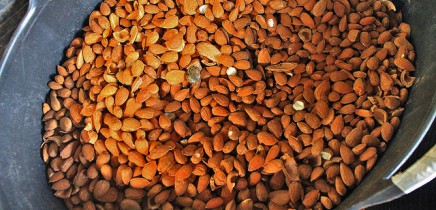
Seed pods become thicker, harder and turn into a brownish colour. From mid/end of October, depending on the weather and degree of ripeness, the outer coat bursts open.
Harvesting gets started.
Therefore, a kind of net is spread underneath the tree to catch almonds that are knocked off with a stick. Dry weather is perfect for harvesting.
In former times, hard shells have been cracked laboriously by using a hammer or stone.
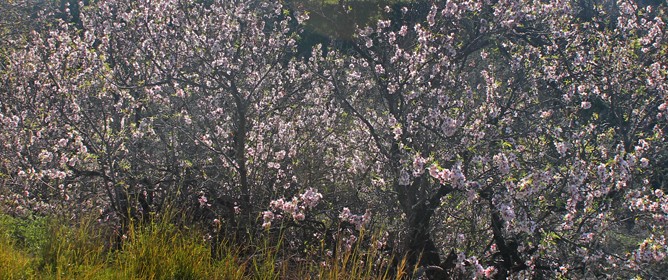
You can still observe this procedure during the annual Almond Blossoming Festival in Puntagorda, which is even a discipline in a competition.
Harvesting in sacks requires the use of appliances...
 It is convenient that Puntagorda has its own almond cracking machine.
It is convenient that Puntagorda has its own almond cracking machine.
In 1963 the "Cooperativa Agrícola Virgen del Pino“ was founded.
At the beginning, this place was used to prepare and pack tomatoes from this region for sale, explains Carlos Manuel Martín Pérez.
However, tomatoes soon became less important and the cooperative purchased a Jabus brand „cascadora“.



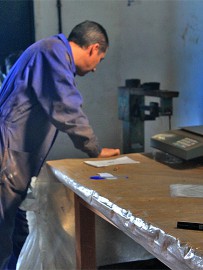
 Carlos ist responsible for receiving the almonds.
Carlos ist responsible for receiving the almonds.
Most of the cooperative members meanwhile are seniors, but also foreign residents bring in their harvest.
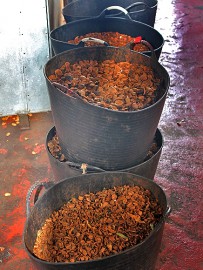
Either the cooperative buys those almonds or owners pick up their cracked-open almonds later.
The Ayuntamiento of Puntagorda also stores up in order to share out almond seeds to the visitors during the Almond Blossom Festival.
Even if almonds are found everywhere around the place, Carlos keeps track of all sacks and buckets.
He knows exactly which almonds belong to whom and splits them by owners and sorts, before filling them separately into the machine's gullet.
Shell almonds, large almonds, sweet almonds, semi-sweet almonds...
It is a noisy and rattling procedure to separate seeds from their shells before the machine spits them out in special containers.
In the Palmerian Kitchen Almonds are used in many Desserts and Sweets
Private persons and bakeries use their harvested almonds to produce almond cheese, almond paste, almendrados, bienmesabe, rapaduras and other treats.
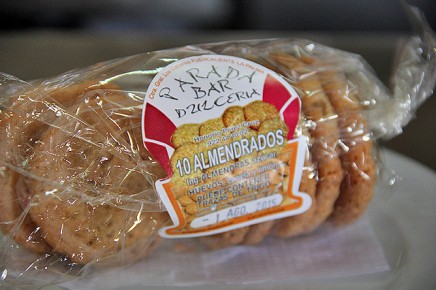
Almond shells are sold. They are popular for smoking goat cheese or for composting and are also used as an isolation material, for example for the floors of caves.
For many centuries profits from the cultivation of from Prunus dulcis contributed to the income of the people of La Palma.
In the 1950s the export peaked by its extension to the United Kingdom (UK).
In 1991 the weight of the peeled almonds was merely 10 tons, and today has shrinked to 3 to 4 tons.
Formerly in Spring Almonds were grafted on existing Bitter Almond Trees
A practical procedure - however, it has a crucial pitfall.

 In case you fail to practice tree maintenance and remove shoots, by tearing them away below the grafts, you possibly harvest original bitter almonds.
In case you fail to practice tree maintenance and remove shoots, by tearing them away below the grafts, you possibly harvest original bitter almonds.
Those are industrially used in other countries but are absolutely bad for La Palma.
Just a tiny amount of bitter almonds in the sack makes it unsellable.
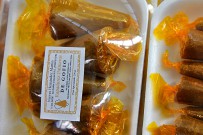
During the grinding or mincing process of sweet almonds the bitter taste ruins the flavour.
Moreover, bitter almonds eaten raw are toxic.
Preferable, other trees of the rosaceous family are used for grafting, like plum or peach.
Almond trees require care

They have to be trimmed every 2 years, otherwise they start "ageing".
Thereby at first small twigs slowly wilt, followed by entire branches. Almond wood is a is an excellent firewood, after all.
Additionally terrains have to be kept grass-free.
Otherwise this could lead to fungus attacks, which destroys trees.
Unfortunately, due to the absence of tree care more and more almond trees are endangered.

It is a great pity, as Palmerian almonds due to the moderated, subtropical climate are of excellent quality.

Although they are more expensive, than those imported from competitors of California, Palmerian people prefer local almonds.
They are part of a healthy diet and the amount of old people on La Palma seem to be a prove that.
For local people almonds, figs, Gofio and goat mild or goat cheese are part of their basic food.
Almond blossom in starlight
„Cooperativa Agrícola Virgen del Pino“

Almonds of the cooperative from Puntagorda are registered under the name „Cooperativa Agrícola Virgen del Pino“ and are sold at following places:
El Rincón de la Fruta, Los Llanos



Gibt es eigentlich die Möglichkeit die Mandeln in Deutschland zu bekommen, bzw. nach Deutschland zu verschicken?
Espectacular!
Das Mandelmus kann man natürlich einfach so aus dem Glas essen, es eignet sich aber auch hervorragend, um es z.B. Salatsosse beizumischen, die wird dadurch nussig und sähmig. Es ist auch ein ganz besonderes Mitbringsel.
Abgesehen davon natürlich sehr gesund und nahrhaft.